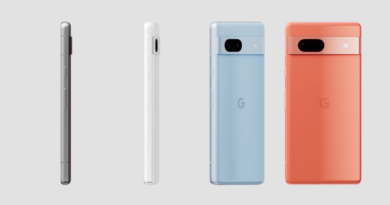Google Pixel Fold is a quality first swing at a foldable

Dismissing foldables as another useless tech trend is getting harder and harder.
While I’m still not personally sold on having one as my personal handset, using the Google Pixel Fold for the past week has me eager to see where foldables go over the next few years. Google’s debut in the realm of phones that bend is almost entirely a successful one.
Its form factor (smartphone-sized outer display with a large, almost square inner display) isn’t especially innovative, but it doesn’t need to be. For all intents and purposes, this is a very good Pixel smartphone that you can also open up and use as a mini-tablet if you want. Its two displays are sharp, its Tensor G2 processor is effective, and its smattering of foldable-exclusive features all work as advertised.
I’d still recommend the Pixel 7 Pro or 7a to prospective Pixel customers, but if you have $ 1,800 burning a hole in your pocket, you could do a lot worse than Pixel Fold.
Galaxy Z Pixel Fold

Those who have followed the progression of foldable smartphones over the last few years will instantly feel a sense of familiarity with the Pixel Fold, seeing as it’s basically Google’s answer to the Samsung Galaxy Z Fold line.
That means it has a 5.8-inch outer display for when you want to use it like a regular smartphone, and a massive 7.6-inch inner display for when you want to bask in its foldable glory. Pulling the phone open takes perhaps 10 percent more effort than I’d like, but I suppose it needs to be hard to unfold so that it never happens accidentally. That’s a compromise I’m willing to live with.
When using the outer display, the Pixel Fold is notably heavy (0.6 pounds) and thicc (0.5 inches) by smartphone standards. Its girth and heft are a little bothersome in this form factor, but neither are ruinous. It doesn’t hurt that when unfolded, the Pixel Fold is as thin as phones come, at just 0.2 inches.
The rest of the Pixel Fold’s physical profile is pretty standard. It comes in two colors (Obsidian and Porcelain) and has a standard power button and volume rocker on the right side. The power button also acts as a fingerprint scanner for security purposes, and unlike the one on the Pixel Tablet, this one actually works most of the time. It’s got face unlock, too, if you’re into that sort of thing.

As for the rest of the Pixel Fold’s most relevant specs, it’s about what you’d expect from a $ 1,500 foldable:
-
120Hz refresh rate
-
4,821mAh battery
-
12GB RAM
-
256GB or 512GB storage
-
Tensor G2 processor
-
Rear camera: 48MP main lens, 10.8MP ultrawide lens, 10.8MP telephoto lens
-
9.5MP front camera
-
8MP inner camera when unfolded
One thing I should mention: The Pixel Fold comes with a USB-C port for charging but not a wall adapter of any kind. You’d think Google could afford to include one of those with a phone that costs nearly $ 2,000.
Big apps for a big screen

As you can see, the Pixel Fold has everything you would want on paper from a foldable Pixel phone. But what’s it like to actually use?
Pretty good, it turns out! When using the outer screen as a regular smartphone, the Pixel Fold is a relatively small but very powerful Pixel phone. Personally, a 5.8-inch display is perfect for me, a person who despises huge phones. I wish there was a regular Pixel phone that small.
Obviously, we’re not here to talk about what the Pixel Fold is like as a normal phone. When you unfold the phone and reveal its almost-square inner display — technically, it has a 6:5 aspect ratio — you’re treated to a massive home screen that manages to fit both of your first two home screen pages onto one display. Assuming you’re smart about app organization (I’m not), you might be able to fit everything you use onto one page thanks to Pixel Fold.
It’s almost like a miniature Pixel Tablet, so much so that UI commands from one will work on the other. For instance, you can multitask with two apps at once by opening an app, swiping up from the bottom to reveal a taskbar, and dragging another app from the taskbar to the side of the screen you want it to take up.

Multitasking is handy for doing things like dragging and dropping a photo from your Photos library into an email or text message. It’s mighty intuitive, and as a bonus, paired apps will group together so you can minimize them and go back to them later without doing the whole taskbar rigamarole again.
A good number of apps have been specially optimized for the Pixel Fold’s inner display, too. These include Google apps like Chrome and Gmail, the latter of which will display your inbox in one column and an email you have open in another. This sort of multi-column display is common among optimized apps; The ESPN app will show news headlines on one side and game scores on the other, for example.

Watching videos via YouTube is also an interesting experience on Pixel Fold. If you fold the phone at an angle and set it on a flat surface, it’ll enter tabletop mode, with the video on the top half and a control panel on the bottom half of the display. I prefer to open the phone all the way for the biggest video display possible, but hey, you do you.
These optimizations for the inner display are generally smart and useful. As is Google’s M.O. with UX design, everything is super slick, elegant, and easy to figure out. I didn’t find myself using the multitask feature organically very often, but that may be a matter of my brain still taking time to adjust to tablet mode when using a smartphone.
All that matters is that these features work exactly as advertised.
Return of Tensor
Of course, it would suck if the Pixel Fold had all these nifty features without the performance to back it up. Blessedly, that’s not the case.
Pixel Fold uses the same Tensor G2 chipset as the last batch of Pixel phones (and the Pixel Tablet), so performance is pretty much 1:1 between those devices and this one. Even when using bigger versions of apps or multitasking, I never noticed any kind of hitching or slowdown. Apps load extremely quickly, and switching between opened apps is a breeze.
Seriously, I wish I had more to say about the Pixel Fold’s performance profile, but it’s so smooth that it’s almost boring. It doesn’t even have battery problems to poke fun at! In my testing, the phone’s battery lasted a little longer than 24 hours with normal use (social media, streaming, etc.). For a $ 1,500 phone, that’s totally fine.
There is one minor issue that comes with frequent use, however. The back of the Pixel Fold can get noticeably warm after you’ve used it for a while. A case would mitigate this, of course, but it’s more irksome here than on other smartphones, so it’s worth pointing out.
A $ 1,500 camera
It’s easy to forget the Pixel Fold has a camera at all, since that’s obviously not the selling point. To Google’s credit, however, the Pixel Fold’s camera array is pretty good and does have some unique foldable features.
It should come as no surprise that normal photos taken through the rear lens look great. Colors are vibrant, everything is sharp as hell, and the subjects of your photos will almost look better than they do in real life.

There’s more to the Pixel Fold as a photography device than meets the eye, though. One cool thing you can do is use the 48MP rear camera to take selfies. Normally, selfie lovers are relegated to a lower-res lens on the front of the phone, but here, you just hit a button in the camera view to move the viewfinder to the outer display. From there, you can take nice portrait mode selfies that look better than they would using the front camera.

Unfolding the phone with the camera app open gives you a gigantic viewfinder and changes the default aspect ratio of photos to be more square-like. I’m a widescreen guy, myself, but it’s nice to be able to take hefty photos like this whenever you want.

You can also put the phone in tabletop mode with the camera app open to simulate the effect of having a tripod. This can be used for group photos (raise a hand to start a timer) or astral photography (not in the light pollution of New York City, though). You can also use it to just take nice shots like this one, if you like.

Naturally, Google’s suite of corrective photo software tricks is present and accounted for. Super Res Zoom from the Pixel 7 Pro makes its return, though it “only” goes up to 20x instead of 30x zoom. Still, I was impressed with this feature; zoomed in photos retain a level of sharpness you just don’t see in a lot of smartphone cameras.


There’s also Night Sight for dark environments, which made our pitch-black backyard look much more attractive at night than it actually looks.

I’d still recommend the Pixel 7 Pro for camera enthusiasts just because it’s far cheaper and can zoom in further, but anyone who gets a Pixel Fold will likely be pleased with the photographic features on display here.
Rookie of the Year
Google’s Pixel Fold, like the Pixel Tablet, is a very solid entry into a new product category for the company that was once best known for a search engine. The Tensor G2 chip impresses once again with fantastic performance, while its most foldable-centric features work like a charm. You even get a nice smartphone camera, as a little bonus.
Nothing is perfect, and neither is the Pixel Fold. It can be a little awkward to use in a folded state due to its size and weight. Meanwhile, the back cover gets hot too easily. You’ll get your fingers all over the outer display while using the inner display, so you better keep a cleaning cloth on you at all times, too.
But those are minor compromises for what is otherwise a major success for Google. At $ 1,800, it’s still a big investment (too big, I’d say), but at least it’s priced equally to the Galaxy Z Fold 4 from a year ago.
I’m still not sure if it’s time to go boldly into the foldable future, but at the very least, you can safely do so without worrying about getting a crappy phone in the process.


